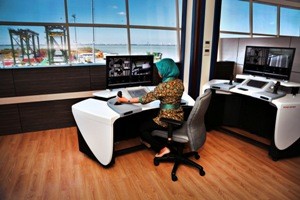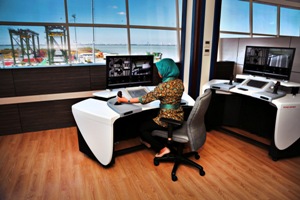 The government of Indonesia has inaugurated the Lamong Bay Terminal in Surabaya, East Java as part of an aggressive drive to improve the national logistics system and make the archipelago a “global maritime axis.”
The government of Indonesia has inaugurated the Lamong Bay Terminal in Surabaya, East Java as part of an aggressive drive to improve the national logistics system and make the archipelago a “global maritime axis.”
Indonesian President Joko Widodo led inauguration rites on May 22 for Lamong Bay Terminal, which features an automated container handling system provided by Konecranes.
“Lamong Bay Terminal is the next generation container terminal,” said Mr. Prasetyadi, project manager at state-owned terminal operator Pelindo III, adding it will be “the key to build up business success in Indonesia and South-East Asia.
Lamong Bay is the first green-concept container terminal in the country and will increase the port’s annual capacity from 1.5 million twenty foot equivalent units to 3.5 million TEUs. Once fully operational, the total capacity of the bay terminal will be 5.5 million TEUs.
It will have an automated container handling system consisting of 20 automated stacking cranes, remote operating stations, associated container yard infrastructure, 10 ship-to-shore cranes, and five straddle carriers. The hand-over of the automated container blocks by Konecranes is said to be moving along smoothly.
The government of Indonesia is establishing a nationwide freight transport program to improve the movement of goods through the country’s vast waterways. The Lamong Bay Terminal is one of the key projects within the program.
Construction of new seaports across Indonesia will be among the priorities under the administration’s medium-term infrastructure development plan, according to the National Development Planning Board (Bappenas).
For the first phase, Bappenas said the state government will prioritize construction of at least seven seaports, such as one in Makassar in South Sulawesi and another in Bitung in North Sulawesi under the National Mid-Term Development Plan for 2015-2019.
Over the long term, the government plans to expand 24 hub seaports, comprised of 11 major ports and feeder ports as well as 13 others designed to facilitate cargo handling.





